V-class group and unknown photos: Difference between revisions
Pbcjohnston (talk | contribs) m Pbcjohnston moved page V-1 group photos to V-class group and unknown photos |
Pbcjohnston (talk | contribs) Moved San Diego photo |
||
| Line 92: | Line 92: | ||
<small>Photo from the private collection of Ric Hedman.</small> | <small>Photo from the private collection of Ric Hedman.</small> | ||
[[File:Red bar sub new.jpg]] | |||
[[File:Bass Argonaut Barracuda March 30 1930.jpg|left|500px]] | |||
<div style="text-align: justify;"><span style="color:#00008B">This excellent photo shows three of the V-class submarines alongside the submarine tender USS Holland (AS-3), moored at an anchorage off Naval Station San Diego, March 30, 1930. From left to right are Holland, [[V-2|'''V-2 (SF-5)''']], [[V-4|'''V-4 (SM-1)''']], and [[V-1|'''V-1 (SF-4)''']]. The radically different hull design of the earlier V-class boats is evident in this photo when compared to V-4. One of V-2's launches is in the water between her and V-4, and one of V-1's boats is underway in the harbor on the far right. At this time there was only the destroyer piers at the 32nd Street base, so submarines and their tender routinely moored to a buoy just off the base. The Ballast Point facility would not be established until after 1959. The launches were used the shuttle the crews of the submarines back and forth to shore for liberty. | |||
<small>Photo in the private collection of Ric Hedman</small> | |||
[[File:Red bar sub new.jpg]] | [[File:Red bar sub new.jpg]] | ||
Revision as of 12:59, 27 April 2024
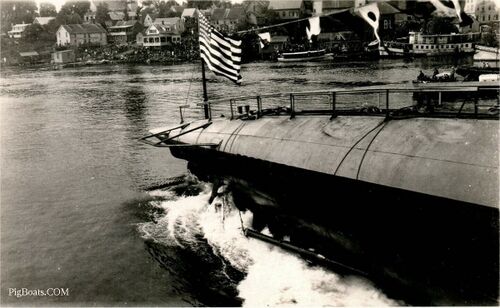
Photo from the private collection of Ric Hedman.
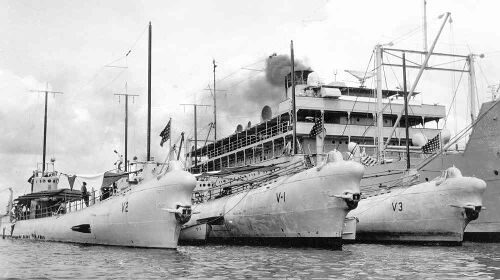
Photo from the private collection of Ric Hedman.
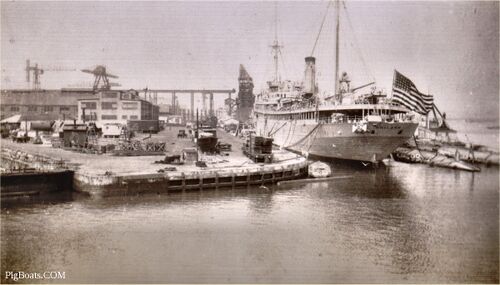
In this 1928 photo the V-2 and the V-3 are moored to the starboard side of the two-year-old submarine tender Holland. (This is reflected in the Navy Yard records.) USS V-1 was in the yard's dry dock # 1 at the time of this photo. All three of the subs were under repair at Mare Island.
Of interest in this photo is the box shaped device on the Holland's stern just to the right of the stern anchor. It looks to be the trash chute. It is a large funnel into which garbage and trash was dumped and directed overboard while at sea.
The photo location is at Mare Island Navy Yard, and is looking north up the Napa River and taken from quay wall south of the entrance to the dry dock #2 between 9th and 10th streets. The dock gate is seen at the lower left. The dock angles to the northwest.
The large crane in the background just beyond Holland is the YD-33 floating crane built in 1918 and was in use at the yard until 1973. It had the capacity to lift 150 tons. The yard's dry dock #1 is to the left of YD-33.
To the left and just north of dry dock #1 and of the YD-33 is the cantilever crane and two hammerhead cranes of the yard's building ways. Heavy cruiser USS Chicago (CA-29) and cruiser submarine V-6 (SC-2) are under construction at this point. (References Mare Island Public Works photos 5032-1-25 & 6529-10-28.)
Just to left of center in the photo is a car. Make and model is unknown but possibly a coupé type.
Photo from the private collection of Ric Hedman. Photo interpretation and detail explanation by Darryl Baker.
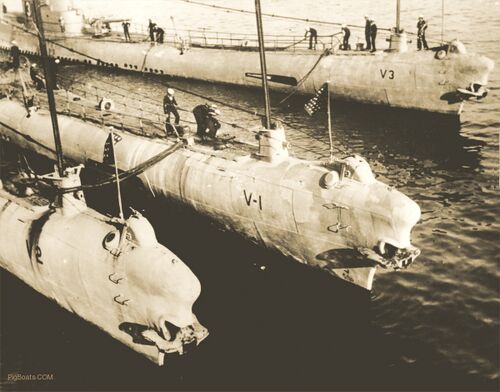
There is a lot of action on the deck of the V-1. To the left a sailor is obviously leaning back in effort to haul a heevie attached to a mooring line across from the V-3. In the center, under supervision of a senior petty officer, a crew of three sailors are pulling the heevie attached to the bow line of the V-3 through a fairlead like the one seen on the starboard side behind the men.
On the deck of the V-3 sailors can be seen feeding a mooring line to be pulled across from line that has been faked out on the deck. This is to ensure it doesn't become tangled or 'fouled' in Navy jargon. The same with the line to the left. An officer and a chief stand at the bow looking aft supervising.
It is interesting in that the first mooring line has not yet been placed on the V-1. We know this since the Union Jack, which will be raised on the jackstaff on the bow, is still in the hands of the Officer's Steward at the far right on the bow, whose job it is to raise it when the boat is officially "moored". The heevies have gone over but no mooring line is yet attached. When the first line is attached the ship's whistle is sounded and the colors are "shifted" to in port from "at sea". The photo is probably 5 to 10 seconds from this happening.
In the foreground on the V-2 there seems to be what looks like a hydraulic or lubricating oil leak in the mechanism that raises the forward radio mast. A large dark streak is running down her hull from the mast housing. The mooring line from the V-1 looks to pass around the base of the mast housing and then been looped around the V-2 capstan, deck shadows support this. The large round object near the topside anchor shank bulge is the vent for the bow buoyancy tank.
Photo from the private collection of Ric Hedman.
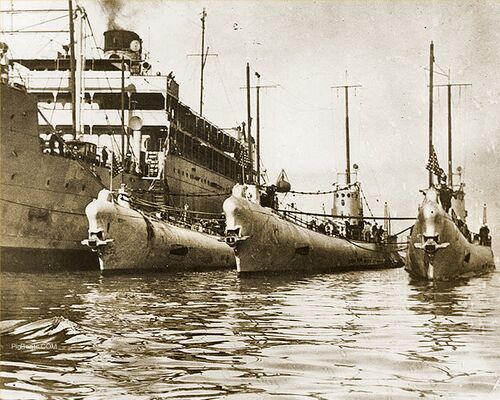
U.S. Navy photo
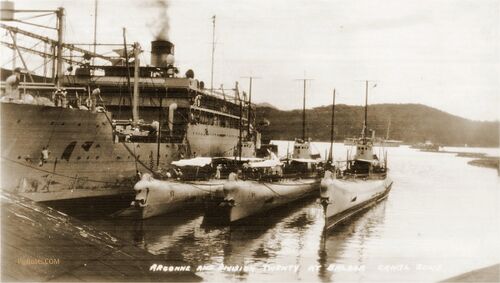
Fleet Problem X was conducted with all available units of the Battle Fleet and Train Squadron Two, opposed by the Scouting Fleet and the Control Force and the defense forces of the 15th Naval District and Army units. The tender and submarines arrived back at San Diego on March 22.
It is interesting that the tender is undergoing painting by the crew. There is a man hanging from a Bosun's Chair at the bow. He is painting the area where the bow flares. This area was known for centuries by sailors as "being between the devil and the deep blue sea" because overhanging areas like this were so hard to word on. The underside of the stern was another area like this. The sailor no doubt has a line attached to him from one of the portholes and is being pulled in close to the hull to work. Another man is hanging from a Bosun's Chair right at the bow of the V-2.
Photo from the private collection of Ric Hedman.
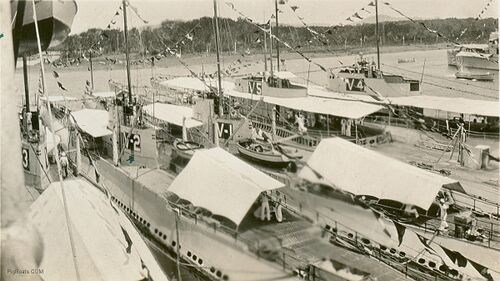
Photo from the private collection of Ric Hedman.
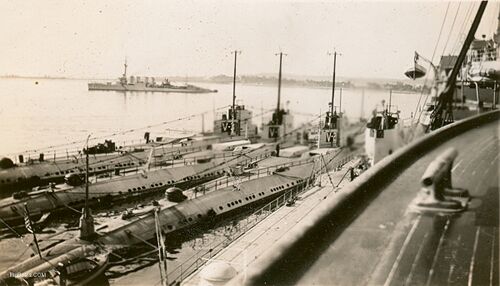
Photo from the private collection of Ric Hedman.
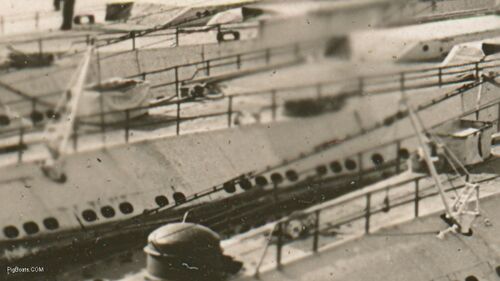
Photo from the private collection of Ric Hedman.
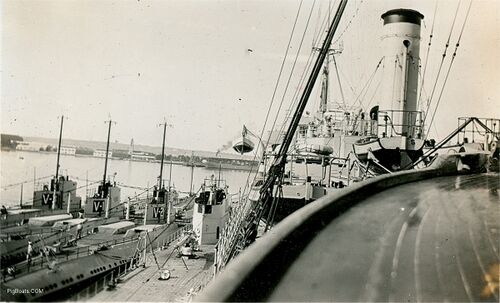
Photo from the private collection of Ric Hedman.
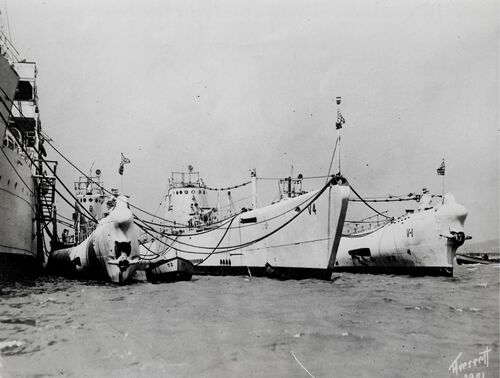
Photo in the private collection of Ric Hedman
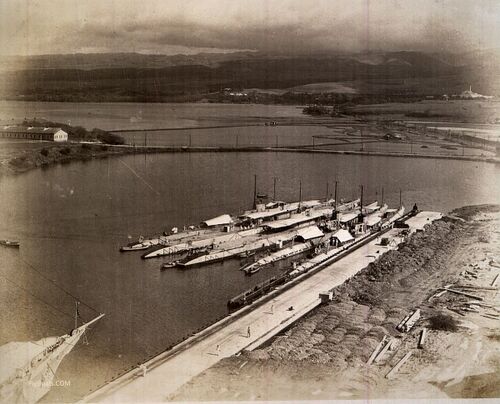
None of these submarines had air-conditioning in this period so awnings were rigged over decks and hatches in an effort to keep the interiors somewhat less stifling.
Photo from the private collection of Ric Hedman.
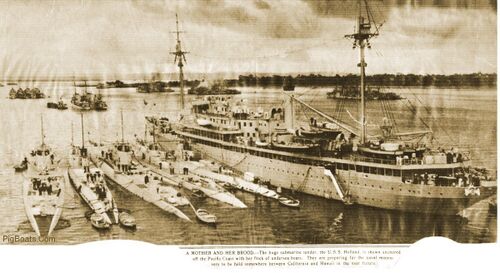
Many vessels are seen in the background. They are presumed to be assembled in the Canal Zone, ready to participate in a big war game, the 1933 Fleet Problem XIV. This war game was to take place in the Eastern Pacific waters that stretched from the West Coast and California shores to the Hawaiian Islands and from south at Magdalena Bay, Baja Mexico north to Puget Sound, Washington State. A vast body of water for this massive war game. The games stressed a lot of independent thought and initiative on the part of commanding officers in the type of tactics used to solve the problems and attain a victory.
Newspaper rotogravurepPhoto in the private collection of Ric Hedman.
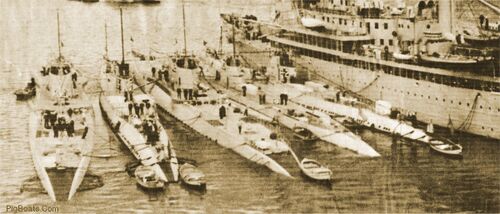
Newspaper rotogravurepPhoto in the private collection of Ric Hedman.
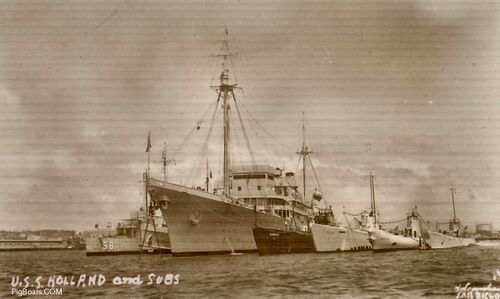
Photo from the private collection of Ric Hedman.
Page created by:
Ric Hedman & David Johnston
1999 - 2023 - PigBoats.COM©
Mountlake Terrace, WA, Norfolk, VA
webmaster at pigboats dot com
